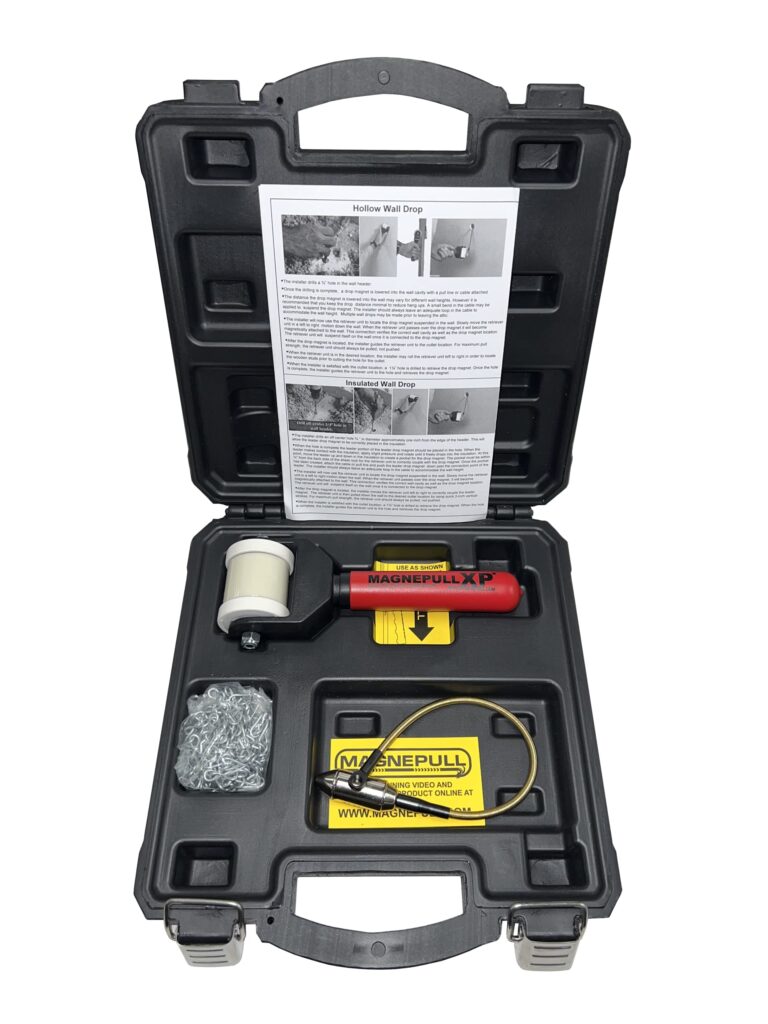Wire pulling tools facilitate the installation of electrical wiring through conduits and panels. They ensure efficient cable management and protection during installation.
Wire pulling tools are essential for electricians and technicians, aiding in the effective installation of electrical systems. These tools come in various forms, including fish tapes, cable pullers, and conduit pistons, each designed for specific environments and cable types. They help reduce the physical strain on workers and minimize the risk of damaging wires during the pulling process.
Optimal use of wire pulling tools enhances safety and productivity on job sites, making them indispensable for modern electrical installations. They blend functionality with innovation, providing solutions that streamline the complex process of wiring buildings and infrastructure.

Credit: www.amazon.com
Types Of Wire Pulling Tools
Professionals know that finding the right tool makes any job easier. In the electrical world, effective wire installation contributes to a job well done. This requires the best wire pulling tools. Wire pulling tools come in various forms. Each design targets specific tasks within the cable installation process. Here is an essential guide to the types of wire pulling tools and their uses:
Fish Tapes
Fish tapes are common in electricians’ toolboxes. They assist in drawing wire through conduit and tight spaces. Made from flexible, yet sturdy materials like steel, fiberglass, or nylon, their purpose is clear:
- Navigate complex paths in existing walls or enclosures
- Minimize friction with a smooth, streamlined design
- Offer versatility with various lengths to tackle any sized project
Glow Rods
Glow rods shine in low-light conditions. Their luminescent properties make them ideal for:
- Tracking paths inside dark enclosures
- Pushing and pulling wires over ceilings, under carpets, and through wall cavities
Pulling Grips
For heavy-duty tasks, pulling grips offer the strength needed. They securely latch onto cables, enabling effortless handling:
Confidently manage heavy and multiple cables in a single pull
| Material | Application |
|---|---|
| Wire Mesh | Industrial environments |
| Rubberized Grips | Indoor, residential projects |
Conduit Pistols
Conduit pistols add precision to pulling. Aimed at professional usage, they:
Differ in size and power depending on the conduit size and length of wire run
Uses Of Fish Tapes
Fish tapes are essential tools for electricians and DIY enthusiasts alike. These flexible, slender lengths of wire or fiberglass help guide electrical wires through walls, ceilings, and floors. Pulling wires can be a tricky task, but fish tapes make it much more manageable. Let’s explore the various ways fish tapes can be used to simplify electrical installations.
Overview Of Fish Tapes
Fish tapes come in various lengths and materials. Steel tapes are robust, perfect for conduit with bends. Fiberglass tapes are non-conductive, safer for live circuits. Most fish tapes feature a hooked end to attach wires, for smooth pulling action.
Fishing Wires Through Conduits
Conduits protect wires, yet threading them can be tough. Insert the fish tape into the conduit, attach wires to the leader, then pull. This method safeguards the wire insulation, ensuring a safe electrical system. Fish tapes glide through pipes, making installation quick and efficient.
Fishing Wires Under Carpet Or Flooring
Fish tapes are not limited to walls and ceilings. Run wiring under carpets or raised floors without damage or noticeable bumps. The tape’s flat design means hidden wire installation is simple. Electricians often rely on fish tapes for these tough in-floor applications.
Glow Rods For Wire Pulling
Wiring jobs demand precision, safety, and the right tools. In dark spaces, glow rods are the go-to tool for electricians. These rods shine brightly, guiding wires through narrow paths and tight spots in walls, ceilings, and conduits.
Overview of Glow RodsOverview Of Glow Rods
Glow rods, often crafted from fiberglass, provide a glowing tip to navigate through dark areas. They come with attachments like hooks, rings, and magnets to pull wires effectively.
Flexible Glow RodsFlexible Glow Rods
For those hard-to-reach spots, flexible glow rods bend without breaking. They weave through obstacles with ease.
- Bendable up to 90 degrees
- Ideal for tight curves
- Luminous in dark environments
Rigid Glow Rods
When you need extra push, rigid glow rods are your ally. They have minimal flex and drive wires through longer straight runs.
| Length | Diameter | Visibility |
|---|---|---|
| 4-6 feet | 1/4 inch | High |

Credit: fieldedge.com
Pulling Grips For Heavy Duty Wire Pulling
Heavy-duty wire installations demand reliable tools. Pulling grips meet this need perfectly. These essential tools manage the demands of pulling wires through various conduits. Understanding the right type of pulling grip is crucial for effective and safe wire installation.
Overview Of Pulling Grips
Pulling grips are indispensable for electricians. They offer a secure connection to wires during the pulling process. This prevents damage to the wire and ensures safety. Let’s explore the different types of pulling grips designed for heavy-duty tasks.
Basket-type Pulling Grips
Basket-type pulling grips secure wires with a net-like structure. They are known for:
- High durability
- Flexibility for different wire sizes
- Ease of attachment and removal
These grips work well for moderate loads and smooth conduit runs. Their woven design distributes pulling forces evenly across the cable.
Multi-weave Pulling Grips
When pulling heavy cables, multi-weave pulling grips are vital. They stand out with:
- Multiple weave patterns
- Extra strength for heavier cables
- Enhanced grip to prevent slippage
Multi-weave grips handle high-tension pulls in industrial settings. They are essential for long pulls and large diameter wires.
Conduit Pistols For Small Conduits
Electricians often deal with the challenge of wiring through tight spaces. Conduit pistols for small conduits can be incredibly helpful. They ensure the job is not only faster but safer and more efficient. Read further to discover how these innovative tools can advance your electrical projects.
Overview Of Conduit Pistols
Conduit pistols are specialized tools designed for electrical wire pulling. They work excellently in small conduit sizes that are usually tricky to navigate. These devices simplify the process of threading wires through conduits with precision and ease.
Uses Of Conduit Pistols
- Threading wires in residential and commercial settings.
- Working with telecommunication lines.
- Ensuring electrical installations in compact spaces.
- Maintaining cleanliness and organization in wiring tasks.
Benefits Of Using Conduit Pistols
The benefits of using conduit pistols are many:
| Benefit | Description |
|---|---|
| Time-Saving | They minimize effort and time spent pulling wires. |
| Efficiency | Enhanced wire-pulling accuracy in small conduits. |
| Safety | Reduce risk of wire damage and personal injury. |
| Convenience | Easy to use in tight or crowded spaces. |

Credit: www.amazon.com
Factors To Consider When Choosing Wire Pulling Tools
Finding the best wire pulling tools requires understanding various factors. These details ensure the right choice for safety and efficiency. Focus on the tool’s design, wire specification, and conduit attributes. Let’s explore these critical aspects.
Type Of Wire
The wire’s material and function are crucial. Different wires resist abrasion differently. Use tools that match wire sensitivity. Copper, aluminum, and fiber optics demand specific tools. Easy wire identification aids in appropriate tool selection.
Length Of Wire
Longer wires need more robust tools. Increased length adds tension. Reliable tools reduce potential snags. Consider tools with precision tracking and tension control for longer installations.
Diameter Of Conduit
The diameter affects tool compatibility. Ensure the tool fits within the conduit while providing room for the wire to move. Match tool size with conduit dimensions. Large tools may damage smaller conduits. This might compromise wire integrity.
| Conduit Diameter | Suggested Tool Size |
|---|---|
| 0.5 inches | Small |
| 1 inch | Medium |
| 2 inches and above | Large |
- Align tool size with conduit diameter for smooth operation.
- Small conduits require finesse, not force.
- Measure the conduit’s inner diameter.
- Select the corresponding wire pulling tool size.
- Check for smooth insertion and pulling.
Frequently Asked Questions On Wire Pulling Tools
What Tool Is The Best To Use To Pull Wire?
The best tool for pulling wire is a cable puller or fish tape, which offers precision and ease for electricians and DIY enthusiasts alike.
What Device Is Used To Pull Wire?
A wire puller, also known as a cable puller or fish tape, is the device commonly used to route or pull wire through conduit or tight spaces.
Which Of The Following Tools Should Be Used In Pulling Wires?
Use wire pullers, fish tapes, or cable lubricants for pulling wires through conduits. These tools help ensure efficiency and protect the wire insulation from damage during installation.
Is Pulling Wire Hard?
Pulling wire can be challenging, particularly for long distances or through tight conduits. Using proper tools and techniques ensures efficiency and reduces physical strain.
Conclusion
Selecting the right wire pulling tools is crucial for efficient and safe electrical work. Whether you’re a professional electrician or a DIY enthusiast, investing in quality equipment pays off in spades. Remember, a set of dependable tools can make the difference between a job well done and unnecessary headaches.
Choose wisely and work smarter.


